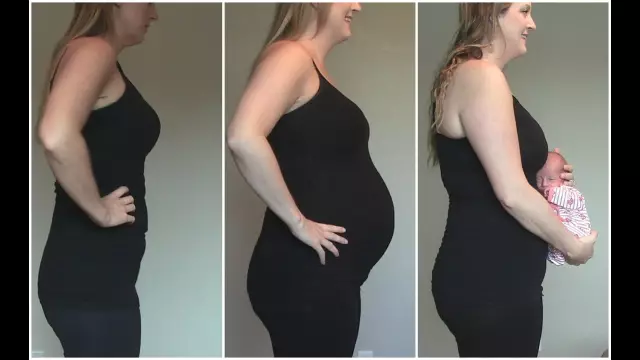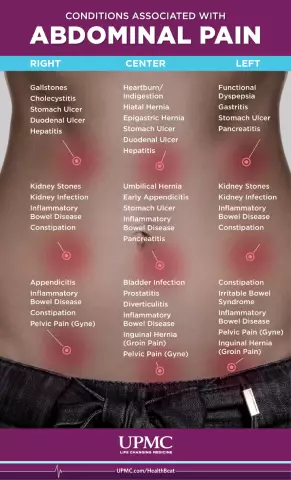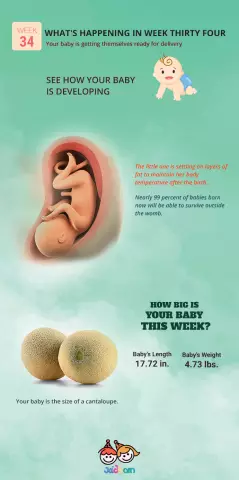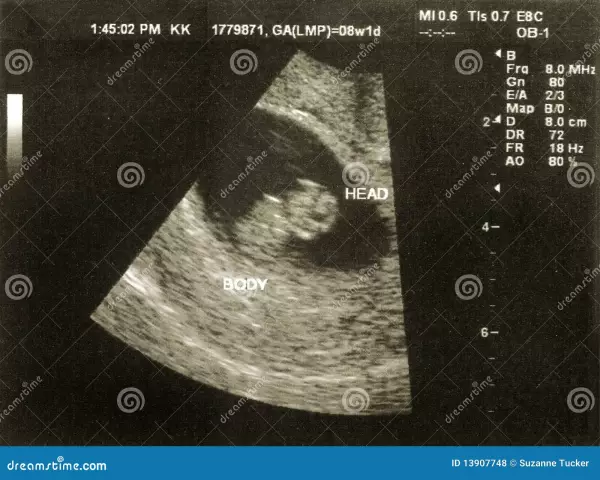- Author Rachel Wainwright [email protected].
- Public 2023-12-15 07:39.
- Last modified 2025-11-02 20:14.
30 weeks pregnant

At 30 weeks gestation, the fetus turns 28 weeks from the moment of its appearance, when the sperm fertilized the egg in the fallopian tube. This is the middle of the eighth month of pregnancy according to the lunar calendar. Since that time, a woman is legally entitled to maternity leave.
Changes in the fetus
By ultrasound at 30 weeks of gestation, it can be established that the length of the unborn child has already grown by 40 cm, and its weight reaches 1350-1500 g. The bone and muscular systems are intensively developing, a small amount of adipose tissue has already been deposited in the subcutaneous fatty tissue.
The fetal lung tissue at the 30th week of pregnancy continues to improve - new alveoli are formed in it and surfactant accumulates.
The nervous system is developing at a rapid pace at the 30th week of pregnancy, many new furrows and convolutions have appeared on the surface of the brain. The nerve fibers are covered with a protective myelin sheath, so that nerve impulses can be carried out at a higher speed.
The skin looks somewhat wrinkled, and lanugo (vellus hair) begins to gradually disappear from its surface.
In the fetal liver at the 30th week of pregnancy, there are already quite a lot of iron stores, which are necessary for the formation of red blood cells.
In the case of the first birth, the future baby takes its permanent position in the uterus - most often upside down. In multiparous women, the tone of the uterus and muscles of the anterior abdominal wall is somewhat lower, and the fetus can still change its position in it. The former freedom of movement in the uterine cavity at the 30th week of pregnancy is no longer there, the unborn child is in an embryonic position, since it occupies a minimum volume in the uterine cavity.
Changes in a woman's body at 30 weeks of gestation
The height of the abdomen at 30 weeks of gestation above the level of the pubis is about 30 cm, the bottom of the uterus is determined 10 cm above the navel. The waist is smoothed, and the posture and gait have changed due to the shift in the center of gravity so that they even received the name "proud posture of pregnant women."
At the 30th week of pregnancy, it becomes quite difficult to endure various loads, not to mention a long forced situation, the advisability of maternity leave from this period does not raise questions for anyone. The total weight gain by 30 weeks is somewhere around 10-11 kg.
At this time, a woman can be disturbed by many rather unpleasant symptoms. A growing belly at 30 weeks gestation stretches the skin, causing itching and sometimes stretch marks. To prevent them, some experts recommend using special creams.
Abdominal pain at 30 weeks of gestation is not uncommon. From time to time, the uterus is toned, exercising for childbirth or after excessive physical exertion, and this can cause pain. This condition is not dangerous. But if the pain at 30 weeks of pregnancy is accompanied by the feeling that the belly below is becoming stone, then you should not stay without a medical examination, as this can threaten to terminate the pregnancy.
The uterus compresses the adjacent organs and blood vessels from the inside, which can lead to constipation, heartburn, and frequent urination at 30 weeks of gestation.

At this time, the pregnant woman constantly feels the movements of her unborn child, she must control their frequency. Regular movements of the fetus indicate that everything is in order with it.
Discharge at 30 weeks of gestation from the genital tract is an indicator of its successful course. Normally, they are whitish in color, with a slightly sour smell and uniform. The appearance of yellow, greenish or gray discharge at the 30th week of pregnancy is most likely a sign of an infection, which means it can threaten the fetus and the further course of pregnancy.
If spotting appears from the vagina at the 30th week of pregnancy, you should immediately call an ambulance. This can be the onset of preterm labor at 30 weeks gestation.
Examination at 30 weeks of gestation
The third ultrasound scan at 30 weeks of gestation is scheduled as planned. This is another control of the health and size of the fetus. With the help of ultrasound, you can find out the sex of the baby, if the previous time he did not show his external genitals.
From 30 weeks of pregnancy, it is required to repeat a blood test for HIV and syphilis, a vaginal smear for microflora. Also, before the next visit to the gynecologist, it is recommended to pass urine for a general analysis. It will exclude the appearance of signs of gestosis (protein, casts, sugar) or infection. Other signs of preeclampsia are usually edema, excess weight gain, increased blood pressure, and sometimes visual impairment.
At a doctor's appointment, a woman should talk about her concerns in order to take timely measures to eliminate undesirable consequences for her and her baby.
YouTube video related to the article:
Found a mistake in the text? Select it and press Ctrl + Enter.






